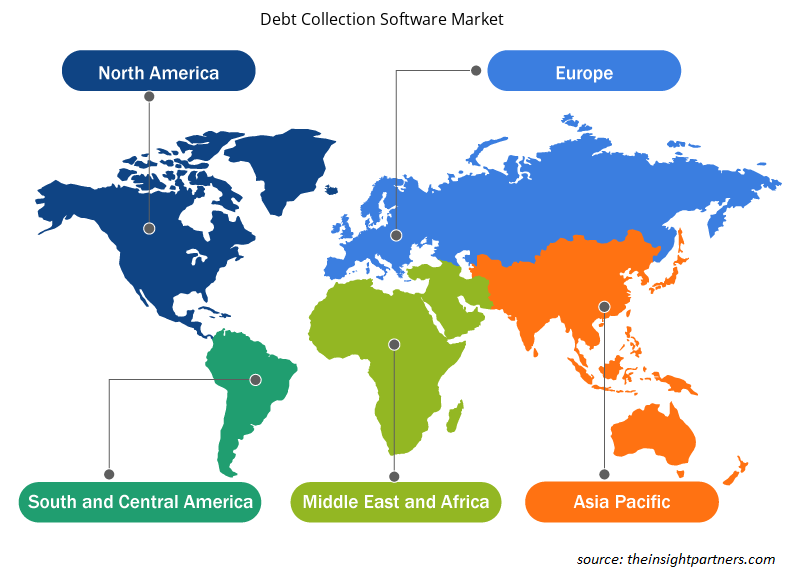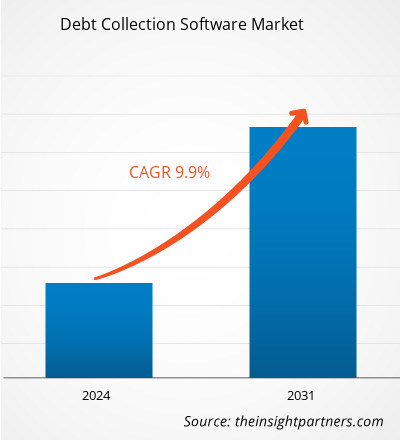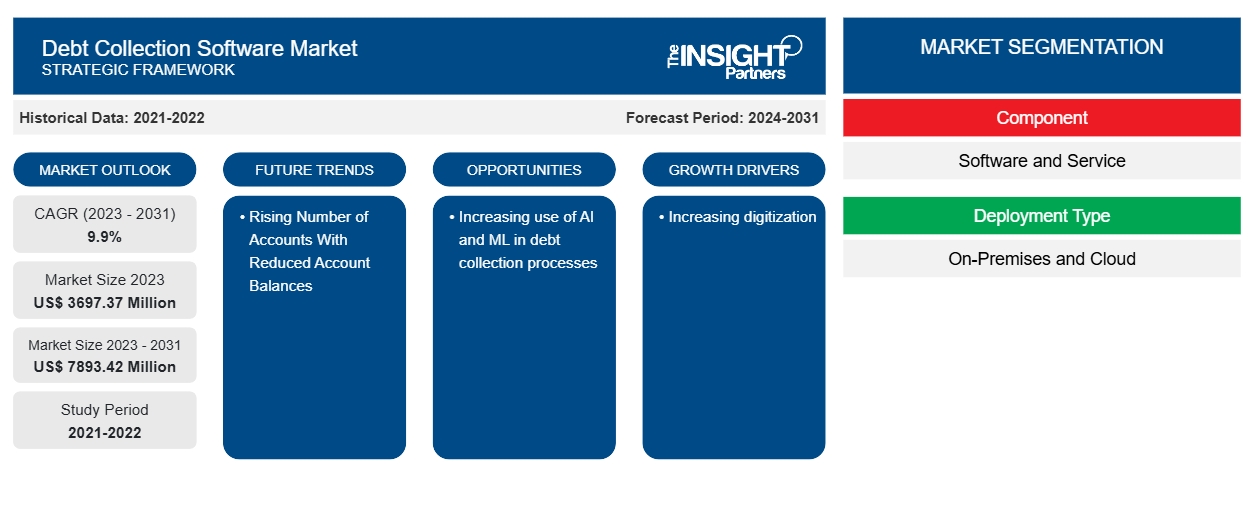채무 회수 소프트웨어 시장 규모는 2023년 36억 9,737만 달러에서 2031년 78억 9,342만 달러로 성장할 것으로 예상됩니다. 이 시장은 2023~2031년 동안 9.9%의 CAGR을 기록할 것으로 예상됩니다. 계좌 잔액이 감소한 계좌 수가 증가하는 것은 시장의 주요 추세로 남을 가능성이 높습니다.
채무 회수 소프트웨어 시장 분석
채무 회수 소프트웨어는 다양한 이점을 제공합니다. 주소, 신용카드 정보, 현재 잔액, 채무의 연체 금액, 채무 기간 등과 같은 채무의 연체에 대한 포괄적인 보고서를 포함하여 모든 채무자 프로필을 단일 위치로 컴파일합니다. 채권자와 DCA 간에 채무자의 프로필, 위치, 연락처 정보, 채무에 대한 추가 정보 등에 대한 정보를 교환하는 것이 필수적입니다. BPO는 이 데이터 공유 프로세스의 또 다른 이름입니다. 채무 회수를 위한 소프트웨어와 API는 기업과 소비자 모두로부터 요금을 징수하는 데 사용될 수 있습니다. 따라서 이러한 이점과 함께 채무 회수 소프트웨어 시장이 성장하고 있습니다.
채무 회수 소프트웨어 시장 개요
채무 회수 소프트웨어는 채무 회수에 관련된 다양한 프로세스를 자동화하는 데 사용됩니다. 이 비즈니스 프로세스 자동화는 채무 회수 프로세스의 많은 구성 요소를 간소화하여 마찰을 제거하고 보다 효과적이고 효율적인 회수 노력을 가능하게 합니다. 적절한 시기에 채널에 연결하고 참여하면 고객이 비즈니스를 인식하는 방식이 개선되고 성공적인 결과의 가능성이 결정됩니다. 디지털 채널과 같이 효과적이고 효과적인 대화를 제공하는 모든 요소를 추가하면 자동화, 혼합 참여, API 및 AI가 고객이 상호 작용하는 방식을 변화시키고 더 많은 지불을 더 빠르게 생성합니다.
귀하의 요구 사항에 맞게 이 보고서를 사용자 정의하세요
이 보고서의 일부 또는 국가 수준 분석, Excel 데이터 팩을 포함하여 모든 보고서에 대한 사용자 정의를 무료로 받을 수 있으며 신생 기업 및 대학을 위한 훌륭한 혜택과 할인 혜택을 이용할 수 있습니다.
-
이 보고서의 주요 시장 동향을 알아보세요.이 무료 샘플에는 시장 동향부터 추정 및 예측까지 다양한 데이터 분석이 포함됩니다.
부채 징수 소프트웨어 시장 동인 및 기회
디지털화 증가
COVID-19 팬데믹은 무현금 거래의 도입을 가속화했습니다. 디지털 뱅킹이 표준이며, 채무 추심에는 금융 거래가 포함되므로 디지털화가 은행과 채무 추심 기관의 책임이라는 것은 분명합니다. 연체율이 증가함에 따라 전 세계 대출 기관은 비용 효율적인 방식으로 회수율을 높이기 위해 디지털 채무 추심 기술을 점점 더 많이 활용하고 있습니다. 따라서 증가하는 디지털화가 채무 추심 소프트웨어 시장을 주도하고 있습니다.
부채 징수 프로세스에서 AI 및 ML 사용 증가
AI와 ML을 사용하는 디지털 부채 징수 플랫폼은 효율성을 높이기 위해 다양한 전략을 활용합니다. 일부는 여러 소스와 채널에서 중요한 데이터를 수집합니다. 이 데이터에는 대출인 프로필, 소득, 선택, 신용 및 재무 내역, 지불 추적 기록과 같은 정보가 포함되어 스마트 마이크로 세그먼트를 만들어 대출 기관이 사용하는 기존 징수 전략의 효율성을 높일 수 있습니다. 따라서 부채 징수 프로세스에서 AI와 ML 사용을 늘리면 시장의 기회가 늘어나고 있습니다.
부채 징수 소프트웨어 시장 보고서 세분화 분석
채무 회수 소프트웨어 시장 분석에서 도출된 주요 세그먼트는 구성 요소, 배포 유형, 조직 규모 및 업계 수직 분야입니다.
- 구성 요소에 따라 부채 징수 소프트웨어 시장은 소프트웨어와 서비스로 나뉩니다. 맞춤형 세그먼트는 2023년에 더 큰 시장 점유율을 차지했습니다.
- 배포 유형별로 시장은 온프레미스와 클라우드로 세분화됩니다. 표면 장착 세그먼트는 2023년에 더 큰 시장 점유율을 차지했습니다.
- 조직 규모에 따라 시장은 대기업과 중소기업으로 구분됩니다.
- 조직 규모에 따라 시장은 IT 및 통신, BFSI, 소매, 제조 및 기타로 세분화됩니다.
지역별 부채 징수 소프트웨어 시장 점유율 분석
채무 회수 소프트웨어 시장 보고서의 지리적 범위는 주로 북미, 아시아 태평양, 유럽, 중동 및 아프리카, 남중부 아메리카의 5개 지역으로 나뉩니다.
APAC는 채무 회수 소프트웨어 시장을 지배합니다. 이 지역의 채무 회수 소프트웨어 시장은 터널 조명의 가시성을 개선하기 위한 정부 이니셔티브 증가와 잘 확립된 운송 산업의 존재와 같은 다양한 요인으로 인해 성장하고 있습니다.
부채 징수 소프트웨어 시장 지역 통찰력
Insight Partners의 분석가들은 예측 기간 동안 부채 징수 소프트웨어 시장에 영향을 미치는 지역적 추세와 요인을 철저히 설명했습니다. 이 섹션에서는 북미, 유럽, 아시아 태평양, 중동 및 아프리카, 남미 및 중미의 부채 징수 소프트웨어 시장 세그먼트와 지리에 대해서도 설명합니다.

- 부채 징수 소프트웨어 시장을 위한 지역별 특정 데이터 얻기
채무 회수 소프트웨어 시장 보고서 범위
| 보고서 속성 | 세부 |
|---|---|
| 2023년 시장 규모 | 36억 9,737만 달러 |
| 2031년까지 시장 규모 | 78억 9,342만 달러 |
| 글로벌 CAGR (2023-2031) | 9.9% |
| 역사적 데이터 | 2021-2022 |
| 예측 기간 | 2024-2031 |
| 다루는 세그먼트 |
구성 요소별로
|
| 포함된 지역 및 국가 |
북아메리카
|
| 시장 선도 기업 및 주요 회사 프로필 |
|
채무 회수 소프트웨어 시장 참여자 밀도: 비즈니스 역학에 미치는 영향 이해
채무 회수 소프트웨어 시장은 소비자 선호도의 변화, 기술 발전, 제품의 이점에 대한 인식 증가와 같은 요인으로 인해 최종 사용자 수요가 증가함에 따라 빠르게 성장하고 있습니다. 수요가 증가함에 따라 기업은 제품을 확장하고, 소비자의 요구를 충족하기 위해 혁신하고, 새로운 트렌드를 활용하여 시장 성장을 더욱 촉진하고 있습니다.
시장 참여자 밀도는 특정 시장이나 산업 내에서 운영되는 회사나 기업의 분포를 말합니다. 주어진 시장 공간에 얼마나 많은 경쟁자(시장 참여자)가 존재하는지 그 규모나 전체 시장 가치에 비해 나타냅니다.
채무 회수 소프트웨어 시장에서 운영되는 주요 회사는 다음과 같습니다.
- 체투 주식회사
- 피코
- 주식회사 CSS
- 엑스페리안 정보 솔루션 주식회사
- 엑서스
- 로크슨 솔루션
면책 조항 : 위에 나열된 회사는 어떤 특별한 순서에 따라 순위가 매겨지지 않았습니다.

- 부채 징수 소프트웨어 시장 주요 업체 개요를 알아보세요
채무 회수 소프트웨어 시장 뉴스 및 최근 개발
채무 회수 소프트웨어 시장은 1차 및 2차 조사 이후의 질적, 양적 데이터를 수집하여 평가합니다. 여기에는 중요한 기업 간행물, 협회 데이터 및 데이터베이스가 포함됩니다. 채무 회수 소프트웨어 시장의 몇 가지 개발 사항은 다음과 같습니다.
- University Hospital Zurich(USZ)는 이전 SAP 기반 부채 징수 소프트웨어 솔루션을 Tilbago AG의 Robo-Inkasso로 교체했습니다. USZ에 따르면, 이를 통해 전반적인 수동 작업을 줄이고 총 비용을 줄이는 동시에 더 광범위한 서비스를 제공할 수 있습니다. (출처: University Hospital Zurich(USZ)., 보도자료, 2022년 12월)
- 사람들이 신용카드 부채를 부지런히 갚도록 돕는 것으로 유명한 핀테크 스타트업 Tally가 화이트 라벨 신용카드 부채 관리 소프트웨어 출시를 발표했습니다. 이 B2B 오퍼링은 소비자에게 부채 관리를 위한 더 나은 경로를 제공하려는 Tally의 사명을 확장합니다. 5,000만 명 이상의 사용자를 보유한 대형 상장 소비자 기업인 Tally의 첫 번째 파트너는 2024년 7월에 Tally의 소프트웨어를 사용자에게 출시할 예정입니다. Tally는 기존 투자자로부터 추가 자본을 조달하여 B2B 오퍼링을 개발했으며, 지금까지 플랫폼을 구축하고 확장하기 위해 2억 달러 이상을 조달했습니다. (출처: Tally, 보도자료, 2022년 4월)
채무 회수 소프트웨어 시장 보고서 범위 및 제공물
"채권 회수 소프트웨어 시장 규모 및 예측(2021-2031)" 보고서는 아래 영역을 포괄하는 시장에 대한 자세한 분석을 제공합니다.
- 범위에 포함된 모든 주요 시장 세그먼트에 대한 글로벌, 지역 및 국가 수준의 부채 징수 소프트웨어 시장 규모 및 예측
- 부채 징수 소프트웨어 시장 동향과 동인, 제약 및 주요 기회와 같은 시장 역학
- 자세한 PEST/포터의 5가지 힘과 SWOT 분석
- 주요 시장 동향, 글로벌 및 지역 프레임워크, 주요 업체, 규정 및 최근 시장 동향을 포괄하는 채무 회수 소프트웨어 시장 분석
- 시장 집중도, 히트맵 분석, 유명 업체 및 부채 징수 소프트웨어 시장의 최근 개발 사항을 다루는 산업 환경 및 경쟁 분석
- 자세한 회사 프로필
- 과거 분석(2년), 기준 연도, CAGR을 포함한 예측(7년)
- PEST 및 SWOT 분석
- 시장 규모 가치/거래량 - 글로벌, 지역, 국가
- 산업 및 경쟁 환경
- Excel 데이터세트
최근 보고서
관련 보고서
사용 후기
구매 이유
- 정보에 기반한 의사 결정
- 시장 역학 이해
- 경쟁 분석
- 고객 인사이트
- 시장 예측
- 위험 완화
- 전략 기획
- 투자 타당성 분석
- 신흥 시장 파악
- 마케팅 전략 강화
- 운영 효율성 향상
- 규제 동향에 발맞춰 대응























 무료 샘플 받기 - 채무 추심 소프트웨어 시장
무료 샘플 받기 - 채무 추심 소프트웨어 시장